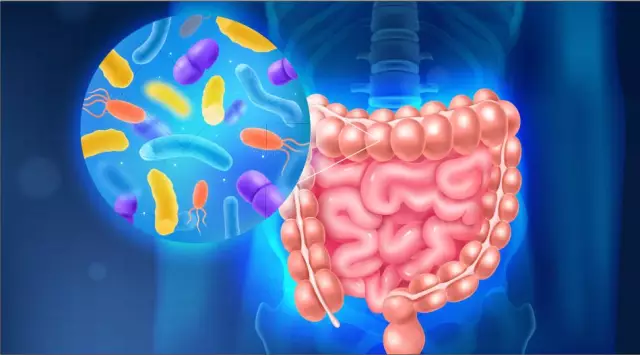- Author Rachel Wainwright [email protected].
- Public 2023-12-15 07:39.
- Last modified 2025-11-02 20:14.
Metabiotics: a new word in the prevention of digestive disorders
The fact that a person lives in symbiosis with certain types of bacteria and viruses is probably known to everyone who is even slightly interested in their health. But not everyone understands how important our connection with the microorganisms that inhabit our intestines and some other organs is. Let's give some illustrative and extremely interesting facts:
- Our body consists of approximately 7-7.5 trillion cells and can be divided into approximately 200 different types (nerve, muscle, epithelial, etc.).
- But the bacteria that live in our body, there are already tens of trillions! And in terms of the diversity of species, they are noticeably leading - this figure is about 10,000.
- In addition, viruses should not be forgotten. In terms of species diversity, they are somewhat inferior to bacteria: only about 1200 types of viruses live in us. But the estimated number of viruses in our body exceeds a quadrillion!
Hence, an unexpected and very amusing conclusion follows: if we consider a person as a kind of symbiotic form of life, then in terms of the total number of cells, we are more likely to belong to nuclear-free organisms:)
Well, jokes are jokes, but all this huge number of viruses and bacteria, which in medicine is called microbiota, lives in us, absorbs something, produces something, and, of course, somehow interacts with our cells and tissues. The question is how exactly? And medical science has already given the answer: with the help of a variety of biologically active substances. That is, chemically, producing certain molecules.

Around the beginning of the 21st century, when the rapid growth of biotechnology began, scientists thought: why not try to isolate these compounds and use them to influence certain processes in the human body? That is, in essence, exclude the microorganisms themselves from this chain of interactions. The research doctors tried it and it worked! This is how a new class of active substances was created, called metabiotics. The prefix "meta-" in this word reflects the fact that these are filtered products of the METabolism of the microbiota.
Why do we need these drugs?
The delicate balance of our internal microflora can be destroyed by many factors:
- aging of the body (dysbiotic conditions are a common problem for people over the age of 60);
- long-term use of antibiotics, which successfully destroy both dangerous bacteria and "useful";
- treatment with hormones, antihistamines and antidepressants;
- almost every of the diseases of the gastrointestinal tract;
- violation of the diet, its sharp changes, as well as starvation;
- stressful situations (especially chronic!);
- immunodeficiency states;
- chronic intoxication, including due to the frequent use of alcohol;
- adverse environmental factors;
- disturbances in the rhythm of sleep and wakefulness.

What threatens us with the destruction of microbiota?
First of all, the consequence is, of course, disruption of the digestive system. A variety of pathologies can arise in it, ranging from diarrhea for a couple of days and ending with such serious chronic diseases as ulcerative colitis or Crohn's disease. In addition, a long-term deficiency of substances that are produced by our microflora will certainly affect the state of the whole organism. For example, dysbiotic disorders are considered one of the causes of obesity, a number of allergic lesions, and chronic fatigue syndrome. Finally, the appearance of our nails, hair and skin is largely dependent on the well-being of the microbiota.
And why such difficulties with the development of a new class of drugs?
This is a natural question. It would seem that there are microorganisms that work successfully in our body. If they die, there are a number of traditional drugs that are designed to restore their number. So why complicate things and bother with their laboratory breeding, and then filtering their metabolic products?
The fact is that metabiotics have several extremely significant advantages:
- In the laboratory we can investigate the structure and composition of each specific molecule included in the metabiotic. This means that we can say exactly what biological effects it will have.
- Considering the previous point, it is easy to conclude that we can control the composition of the resulting drug with high reliability. And change it, adjusting it to the needs that a particular person experiences.
- Finally, knowledge of the composition makes it possible to dose the drug much more accurately.
- Metabiotics are not living organisms, but a collection of chemicals. Accordingly, they have a much longer shelf life and shelf life.
- Dysbacteriosis is a common complication of antibiotic treatment. But live bacteria cannot be used at this moment - antibiotics will simply destroy them. But metabiotic drugs are not afraid of simultaneous use with antibiotic therapy.
- Metabiotics begin to act immediately after entering the body. They are already completely ready to begin to be absorbed into the tissues, and are distributed over them much more evenly.
- Bacteria live primarily in our intestines. But in order to get into it, they have to go through the acidic environment of the stomach. A number of studies have shown that no more than 0.01% of them survive. Metabiotics, on the other hand, are not afraid of increased acidity of gastric juice and up to 97% of such substances enter the intestine unchanged.
- Reception of metabiotics has practically no contraindications. They are well tolerated by people of any age, pregnant women and even babies.

Why not use traditional drugs?
Before the appearance of metabiotics, disturbances in the microflora of the intestine and other organs were corrected by taking pre- and probiotics.
Prebiotics are those compounds that are required for the active growth of microbiota in the human body. The logic of their application is clear: they create a nutrient medium, favorable conditions for the reproduction of symbiotic bacteria. But their action is completely indiscriminate. That is, if there are both “useful” and “harmful” (pathogenic) bacteria in the intestine, then both of them will grow equally successfully on the substrate of prebiotic drugs. And besides, if the intestinal microbiota died (say, under the influence of antibiotic therapy), then the prebiotics simply will have nothing to stimulate.

Probiotics are a more complex class of drugs. This, in fact, is the very "beneficial" bacteria, only in dried form. Once in the warm and humid environment of our body, they come to life and begin to work. Okay? Okay! Solution of the problem? But not quite …
More and more researchers have questioned the effectiveness of probiotics in recent years, and here's why:
- Unlike the simplicity of dosing metabiotics, it is impossible to determine the number of bacteria required by a particular person.
- As we said above, probiotics cannot be taken against the background of antibacterial therapy, and in addition, almost all bacteria die in the hydrochloric acid of the stomach, simply without reaching the intestines.
- Often you can find probiotics containing microorganisms of the genera Enterococcus, Streptococcus, Escherichia, Bacillus, Bacteroides. And these are the so-called conditionally pathogenic bacteria. Our body needs them, but in very small quantities, because when their number increases, they can cause serious diseases. And as we said, dosing probiotics is extremely difficult.
Doubts about the effectiveness of probiotics are already so strong today that government agencies are already responding to them. So, in 2012, the European Food Safety Agency (EFSA) banned the publication on the labels of products with probiotics that they have any medicinal effect. And in 2014, the American Food and Drug Administration (FDA) followed the example of the Europeans.

Where are metabiotics used now?
At the moment, metabiotics have already firmly entered the arsenal of medical remedies for doctors around the world. They are actively used in the treatment of diseases of the digestive system, liver and biliary tract, allergic skin pathologies, etc.
But in addition to this, metabiotics are today considered as a prophylactic agent with clinically proven efficacy. In the form of healthy foods, it is recommended to use it to improve digestion and prevent a number of metabolic disorders in the body.
In our country, such healthy food products under the name "T8 Mobio Metabiotic" are produced by VILAVI INT LTD. The quality of this concentrate is evidenced by the fact that in 2020 it received a declaration of conformity with the requirements of the Eurasian Economic Union. The active formula "T8 Mobio" consists of metafiltrates of all the main symbiotic bacteria of the human body:
- Bifidobacterium adolescentis;
- Lactobacillus acidophilus;
- Lactobacillus salivarius;
- Lactobacillus helveticus;
- Propionibacterium freudenreichii.

Metabiotics are a modern, more effective and safer analog of pre- and probiotics. If you want to take care of your gastrointestinal tract health and get additional protection against a range of metabolic disorders, then periodic intake of T8 Mobio metabiotics will be the smartest choice for you.
Found a mistake in the text? Select it and press Ctrl + Enter.






